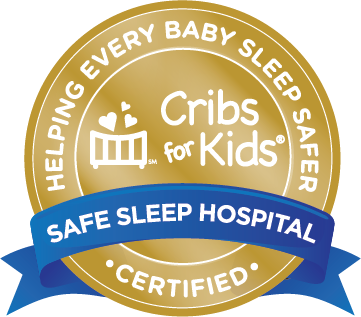Ensuring Safe Sleep for Your Baby
Our Family Birth Place has achieved Gold Safe Sleep Certification, recognizing our commitment to providing the highest level of care and expertise to help you safeguard your little one during those crucial early nights and beyond. We want to empower you with the knowledge and resources you need to give your baby the safest start in life.
At St. Elizabeth Healthcare, safe sleep practices begin during your hospital stay. Our care team provides hands-on education and support throughout your postpartum experience, helping you understand and implement safe sleep habits from day one. You’ll learn best practices like placing your baby on their back to sleep, using a firm sleep surface, and keeping soft objects and loose bedding out of the crib—all aligned with the American Academy of Pediatrics guidelines.

The ABCs of Safe Sleep and Remembering D for Danger
Now that you’ve welcomed your precious bundle of joy, creating a safe and peaceful sleep environment at home becomes a priority. The following tips will help you implement safe sleep practices at home. But these practices are perfect for when you travel, too.
- 1
Alone
Your baby should always sleep alone in their crib or bassinet. While it’s safe for your baby to sleep in the same room as you, do not place them in your bed, on a couch or in a chair. Make sure the sleep space is free of crib bumpers, toys, pillows and blankets.
- 2
Back
Place your baby on their back to sleep, whether at naptime or bedtime. Always use a firm mattress in the crib, bassinet or playpen to reduce the risk of suffocation. Sudden Infant Death Syndrome (SIDS) can happen to a healthy infant under one year, typically occurring during sleep. Soft mattresses and bedding are potential hazards.
- 3
Crib
The safest place for your baby to sleep is in their crib, with only a fitted sheet. If you’re concerned about your baby getting cold, talk to your child’s pediatrician about a safe sleeper to keep them warm at night. Also, do not sleep with your baby in a rocking chair or a recliner. It’s just as dangerous.
- 4
Danger
Stay alert and never use substances that impair your ability to care for your baby. Avoid smoking, drinking alcohol or using drugs while taking care of your little one. These substances increase the risk of an unsafe sleep-related incident.
Safe Sleep on the Go: Car Seats and Strollers
Traveling with your baby can be challenging, especially when it comes to keeping them safe during sleep in a new place. Whether you’re planning a road trip, a flight or just a walk in the park, prioritize safe sleep practices. These guidelines can help you while traveling.
Make Sure Everyone Caring for Your Baby Follows Safe Sleep Guidelines
Remember, everyone who cares for your baby, whether a family member, friend or caregiver, should follow safe sleep practices. Make sure to:
Safe sleep practices and the ABCDs of sleep provide peace of mind for parents during those precious moments of rest. Whether at home or on the go, following these guidelines creates a strong foundation for your baby’s safety.

